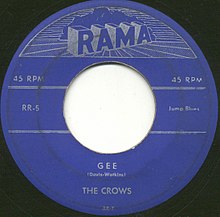Gee (song)
Gee (Engl. For the exclamation man! , Man! ) Is a doo-wop -Song that written by William Davies and Viola Watkins and in February 1953 by The Crows in New York at the independent label Rama Records was released. It reached # 2 on the 1954 Rhythm and Blues - Billboard forex charts and number 14 on the Billboard pop charts and was in the then very popular music show Your Hit Parade played. As the first doo-wop recording in the 1950s, it sold more than a million copies. Gee was one of the first rhythm and blues recordings, which was also successful as a crossover in the pop charts.
The piece
The song begins with a few bars of nonsense text:
- duh-duda-duh-duda-duh-duda-duh-duh-duba
followed by the lead voice:
-
Oh-ho-ho-ho gee, my oh-oh gee-hee, well oh-ho gee, why I love that girl.
- (Oh man, oh man, now why do I love the girl)
-
Oh-ho-ho-ho gee, my oh-oh gee-hee, well oh-ho gee, why I love that girl.
then the group:
-
Love that girl!
- (Love the girl!)
-
Love that girl!
Ritchie Unterberger emphasizes the "infectious, happy harmonies". He describes the instrumental accompaniment as a modified jump blues . The melody is "irresistible", the "street corner singing" naive and enthusiastic.
Emergence
Gee was the third track that was recorded during a recording session on February 10, 1953 at Rama Records. It was arranged within a few minutes by band member William Davis, Viola Watkins is also given as the author. She played the piano and was involved in arranging the piece. The thesis is that the guitar break, which is based on the traditional Scottish melody The Campbells are Coming , could have been recorded by session guitarist Lloyd "Tiny" Grimes .
The play was first as a B-side of the ballad So I Love You published. However, radio stations began turning the record over and playing Gee , first in Philadelphia , then in New York and Los Angeles . By January 1954, 100,000 records had been sold, and by April the piece reached number 2 and number 14, respectively, on the Rhythm and Blues and Pop charts of Billboard magazine . Although at the beginning of 1954, a year after its release, the piece became a big hit, The Crows remained a one-hit wonder , as the pieces released after that were no longer successful and were not included in the charts. A few months after Gee was no longer in the charts, the band broke up.
meaning
Gee is recognized as the first rock 'n' roll record by a rock 'n' roll group because the piece was an original composition and followed a fast dance rhythm. Crying in the Chapel by the Orioles was the first rhythm and blues recording that managed to reach the pop charts in a so-called crossover as a piece by a black music group - as a cover version of a country piece. Gee - and also its back (the actual A-side, see above) I love You So - on the other hand was a self-written song by a group of pure amateur musicians, which emphasizes the importance of the placements achieved in the pop charts. Gee is therefore seen as groundbreaking, it maintains a wonderfully amateurish appearance
The Beach Boys recorded a brief adaptation of the piece as part of the unfinished Smile project . The piece was published in Brian Wilson's solo project Brian Wilson presents Smile (2004). Frank Zappa 's Mothers of Invention played the melody of the piece during their first European tour (September – October 1967). A live recording can be found on Frank Zappa's official bootleg 'Tis the Season to Be Jelly , from the Beat the Boots series , released in July 1991.
Web links
Individual evidence
- ↑ a b c d e Steve Propes, Jim Dawson: What Was the First Rock 'n' Roll Record . Faber & Faber, Boston & London 1992, ISBN 0-571-12939-0 , pp. 124-127 .
- ↑ Gee (Richie Unterberger) at Allmusic (English). Retrieved February 18, 2010.
- ^ Viola Watkins at Allmusic.com
- ^ The Crows. history-of-rock, accessed November 17, 2006 .
- ↑ JC Marion, DooWop Nation No. 7 ( Memento of the original from October 28, 2009 in the Internet Archive ) Info: The archive link was automatically inserted and not yet checked. Please check the original and archive link according to the instructions and then remove this notice.
- ^ Charlie Gillett: The Sound of the City: The Rise of Rock and Roll . 2nd Edition. Da Capo Press, New York, NY 1996, ISBN 0-306-80683-5 , pp. 76 .
- ^ Katherine Charlton: Rock music styles: a history . Brown Publishers, 1990, ISBN 978-0-697-03050-4 , pp. 76 .
- ^ Anthony Decurtis, Holly George-Warren: The RollingStone Illustrated History of Rock & Roll . 3. Edition. Random House, New York 1976, ISBN 0-679-73728-6 , pp. 94 .
